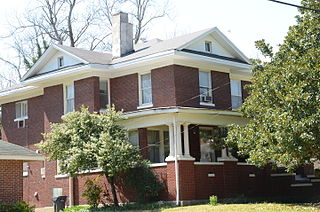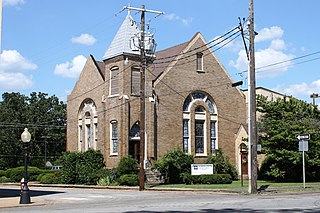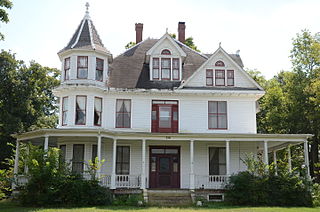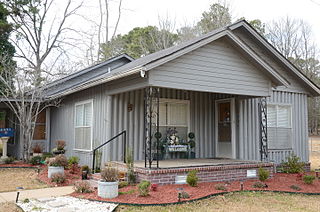
The White House is a historic house at 1101 Perry Street in Helena, Arkansas. It is a two-story brick building, built in 1910 to a design by architect Charles L. Thompson. The Colonial Revival building has a pyramidal roof with projecting gable sections. A single-story porch wraps around two sides of the house, supported by grouped Tuscan columns. The front entry is framed by sidelight windows and pilasters. It is the only surviving Thompson design in Helena.

The Cumberland Presbyterian Church is a historic church at the junction of Race and Spring Streets in Searcy, Arkansas. It is a single-story buff brick Romanesque Revival structure, with a cross-gable roof configuration and a square tower at the right front corner. The tower houses the main entrance in a pointed-arch recess, and has a louvered belfry at the second level below the pyramidal roof. The church was built in 1903 for a congregation organized in 1824, and is a fine example of Romanesque and Classical Revival architecture.

The Davis House is a historic house at the corner of Wolf Street and Arkansas Highway 5 in Norfork, Arkansas. It is a vernacular Plain-Traditional 1-1/2 story frame structure, with a hip roof and a stuccoed foundation. It has a hip-roofed porch extending across its front, and shed-roof dormers piercing its distinctive pyramidal roof on two elevations. The house was built c. 1928 for Charley Blevins, but was owned for about 50 years by members of the Davis family.

The Carroll County Courthouse, Eastern District is a historic courthouse at Public Square in the center of Berryville, one of the county seats of Carroll County, Arkansas. Built in 1881 and repeatedly enlarged, it is now a three-story brick structure with a truncated hip roof, and a pair of four-story towers at its front corners, which are topped by pyramidal roofs. The courthouse was built shortly after Berryville replaced Carrollton as the county seat, and before Eureka Springs was chosen as the county's western seat. The building now houses the Heritage Center Museum of the Carroll County Historical Society.

The Freeman-Felker House is a historic house at 318 West Elm Street in Rogers, Arkansas, United States. It is a large two-story wood frame structure, designed by local architect A. O. Clark and built in 1903 for a banker. The house has a pyramidal roof and a wraparound porch with Classical Revival detailing. A large gable projects slightly on the main facade, with a Palladian window at its center. The house includes a sunroom, added in the 1930s by its second owner, J. E. Felker, and also designed by Clark.

The Cowdrey House is a historic house at 1 Valley Street in Yellville, Arkansas. It is a 2 1⁄2-story wood-frame structure, with asymmetrical massing and a pyramidally-roofed turret typical of the Queen Anne style. Built in 1904, the house is particularly notable for its interior woodwork, which was made in Memphis, Tennessee and transported to Yellville for installation. It was built by J. S. Cowdrey, whose family were early settlers of the area and were involved in many local businesses. The Cowdreys hosted future President of the United States Herbert Hoover in 1927.

The Jackson House is a historic house in Bentonville, Arkansas. It is a 2 1⁄2-story wood-frame house, roughly cubical in shape, with a pyramidal roof and an asymmetric facade typical of the Queen Anne style. It has a wraparound single-story porch, supported by Corinthian columns, with flat sawn balusters. There is a small Palladian window in a front-facing projecting gable section. The house was built c. 1902.

The James House is a historic house on Benton County Route 51, between Osage Creek and Sunbridge Lane outside Rogers, Arkansas. Built c. 1903, the house is a high-quality brick version of a locally distinctive architectural style known as a "Prow house". It is an American Foursquare two-story structure with a truncated pyramidal roof, with a gable-roofed section that projects forward, giving the house a T shape with the stem facing forward. The property also includes a combination smokehouse-root cellar, also built of brick, which appears to date to the same period, and is unique within the county.

The Parks-Reagan House is a historic house at 420 West Poplar Street in Rogers, Arkansas. Built in 1898, this two-story Colonial Revival house is one of the finest and oldest in Rogers. It is a wood frame structure, roughly square in shape, with a pyramidal roof and a forward-projecting gable-roof section. A single-story porch wraps around the front and side of the house, with a gable-pedimented section marking the entry stairs. The house was built for George Parks, a local merchant, and has since 1923 been owned by the Reagan family.

The Bryant-Lasater House is a historic house at 770 North Main Street in Mulberry, Arkansas. It is a 1-1/2 story wood frame structure, set on a foundation of molded concrete blocks, with a shallow-pitch pyramidal roof, and a hip-roof porch extending across the front. A rear porch has been enclosed. Built c. 1900, the house is locally distinctive for its architecture, as a particularly large example of a pyramid-roofed house, and for its historical role as the home of a succession of locally prominent doctors, including Dr. O. J. Kirksey, who operated a maternity hospital in the house.

The Hoag House is a historic house in Judsonia, Arkansas. It is located on a wooded lot northeast of the junction of Arkansas Highways 157 and 367 in the northeastern part of the town. It is a rambling two-story wood frame structure, with central section oriented north-south, and projecting gabled sections on the east and west sides. A two-story turret stands at the northeast junction of the main and eastern sections, topped by a pyramidal roof with gable dormers. A single-story porch with Victorian decoration wraps around the outside of the turret, joining the northern and eastern sections. Built about 1900, the house is locally distinctive for its central two-story box structure, and its Folk Victorian styling.

The Compton-Woods House is a historic house at 800 High St. in Little Rock, Arkansas. It is a 2 1⁄2-story wood-frame structure, with a cross-gable roof configuration, and wooden clapboard and shingle siding. It is a fine local example of late Queen Anne Victorian style, with a three-story square tower in the crook of an L, topped by a pyramidal roof. Decorative cut shingles adorn the upper floor. The interior features high quality period woodwork in mahogany, oak, and pine. Built in 1902, it is a surviving example of houses that were typically seen in its neighborhood, just south of the Arkansas State Capitol.

The Koon House No. 1 is a historic house at Arkansas Highway County 167 and Grant County Road 523 in Sheridan, Arkansas. It is a single story structure, built out of small logs split in half and set facing round side out and smooth side in. Its front facade is dominated by a projecting gable-roofed porch. The house was built in 1940 by Hillary Henry "Pappy" Koon, and is one of several houses built in this distinctive manner in the area by Koon.

The Koon House No. 2 is a historic house at 2959 Arkansas Highway 167 in Sheridan, Arkansas. It is a single story structure, built out of vertically-placed small logs, split in half and set smooth side in and round side out. It is roughly T-shaped, with a frame addition and a carport added later in the 20th century. The house was built in 1936 by Hillary Henry "Pappy" Koon, and is one of several houses built in this distinctive manner in the area by Koon. It is the first of the type he built, and was used as his family residence.

The Koon House No. 3 is a historic house at 2988 Arkansas Highway 167 in Sheridan, Arkansas. It is a single story structure, built out of vertically-placed small logs, split in half and set smooth side in and round side out. It is roughly rectangular in shape, with a gable roof and a gabled front porch. A small rectangular section projects from on side near the rear. The house was built about 1940 by Hillary Henry "Pappy" Koon, and is one of several houses built in this distinctive manner in the area by Koon.

The Koon House No. 4 is a historic house at 3004 Arkansas Highway 167 in Sheridan, Arkansas. It is a single story structure, built out of vertically-placed small logs, split in half and set smooth side in and round side out. It is roughly rectangular in shape, with a cross gable roof. A rectangular section projects from on side near the rear, and it has a front porch recessed under a gable projecting from the left front. The house was built about 1940 by Hillary Henry "Pappy" Koon, and is one of several houses built in this distinctive manner in the area by Koon.

The Koon House No. 6 is a historic house at 3253 Arkansas Highway 167 in Sheridan, Arkansas. It is a single story structure, built out of vertically-placed small logs, split in half and set smooth side in and round side out. The west (rear) side has been refinished in wood paneling. The building is roughly rectangular in shape, with a gable roof and a gabled front porch, which shelters a recessed entrance. The house was built about 1940 by Hillary Henry "Pappy" Koon, and is one of several houses built in this distinctive manner in the area by Koon.

The Avanell Wright House is a historic house at Main and Pine Streets in Pangburn, Arkansas. It is a single story L-shaped wood frame structure, with a stone foundation, novelty siding, and a cross-gable roof that has a central pyramidal section. The roof line of the central section extends downward over a porch located in the crook of the L, with Tuscan columns for support. The house was built about 1910, and is one of relatively few surviving houses from that period in the community.

The Center Valley Well House is a historic pump house on the grounds of the Center Valley Elementary School on Arkansas Highway 124 in Russellville, Arkansas. It is an open-walled square stone structure, consisting of low stone walls and corner posts, which support a shallow-pitch pyramidal roof. The roof has exposed rafter ends in the Craftsman style, and the walls are capped by concrete coping. Two of the walls have openings, which provide access to the interior of the structure, which has a concrete floor. It was built in 1940 to shelter the well providing water to the original 1939 school building, using materials left over from its construction. It is a distinctive, yet modest, example of WPA architecture in the community.

The Dr. Charles H. Kennedy House is a historic house at 6 Edenwood Lane in North Little Rock, Arkansas. It is a single story steel frame structure, organized as three hexagonal pods joined by linear sections. The pods divide the house's functional spaces: one is for public living spaces and amenities, including the kitchen, living room, and dining area, one has the master bedroom suite, and one has a guest space and playroom. The exterior is clad in a combination of brick veneer and vertical board siding, and the roof is flat except for the pods, which have pyramidal roofs. The house was built in 1964 to a design by noted Arkansas architect Warren Segraves.


















